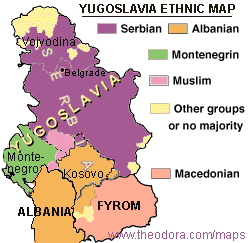

First, the Serbs stripped the Albanians of their constitutional autonomy, restricting or out right repealing their rights. As a response, the Kosovo Liberation Army (KLA), was formed, in a Albanian effort to rid Kosovo of the Serb Army, which was suddenly active in repressing the population, and spreading the will of Slobodan Milosevic.
The province was soon engaged in ferocious guerilla fighting between the KLA and Serb forces. By March 24, 1999, almost 45,000 Albanians had left Kosovo for the neighboring countries of Albania and Macedonia, forced to flee their homes because of the fighting. Hundreds more had been brutally slaughtered by the Yugoslav army.
The world had not been standing idly by once fighting raged, however. After realizing the extent of the problem in Kosovo, the North Atlantic Treaty Organization (NATO)got involved. At the Rambouillet Accords of February and March, 1999, the North Atlantic Council, NATO’s decision making body, chaired a peace conference in Rambouillet, France. NATO, KLA, and Serb represenatatives met there to discuss a diplomatic solution for Kosovo. True to their name, the KLA wanted liberation for Kosovo; in essence, they wanted NATO to make Kosovo independent. Of course the Serbs would not stand for this. They insisted that Kosovo remain part of Serbia. In time, a treaty was worked out that the KLA, while unhappy with not being granted independence, would sign for and endorse. The Serbs on the other hand, did not try to negotiate, did not try to compromise, but instead stood firm on what they were doing.
The Serbs and Albanians both have legitimate claims to Kosovo. The Serbs regard Kosovo as a holy ground. Many Serb religious facilities are in Kosovo. Also, there are many historical sites from the Serb past. Kosovo was the premier battle of Serb culture- for them to lose Kosovo, would be like America losing Gettysburg.
The Albanians claim Kosovo beause they are the overwhelming majority of the population, just under 2 million people. They thought that what mattered now is important, and they are there now.
 |
| Ethnic map: Albanians are in orange |